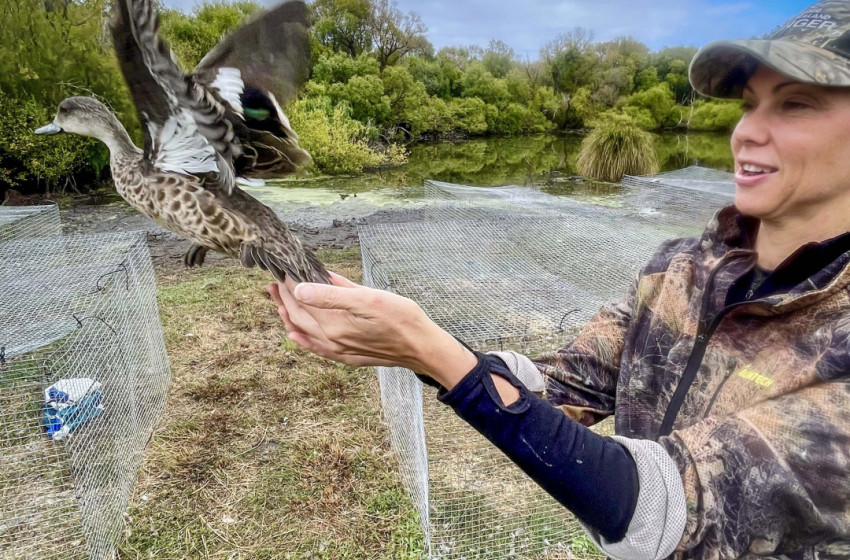Counting on it – Fish & Game staff checking on wildlife numbers to manage species
- 22/03/2024
- Richie Cosgrove

Fish & Game staff across the country are out of their offices catching and counting birds or kitted up in wetsuits to count fish.
Fish & Game New Zealand chief executive Corina Jordan spent two days recently helping the Taranaki and Wellington offices banding mallard and grey ducks.
“It’s great to get away from computer screens and meetings. to get out in nature and get stuck in with the team doing valuable monitoring work as CEO of Fish & Game,” says Jordan, who helped band 500 birds.
“Every year we band about 3500 birds in Auckland and Waikato and a further 3000 in Taranaki and Wellington and a further 1800 in our Eastern region. We’ve been banding waterfowl for more than 30 years because it’s important we have a good understanding of numbers and harvest rates so we can sustainably manage hunting.”
Birds are tempted with grain and information about their age and sex is recorded when birds are banded with a uniquely numbered band attached to their leg. We also get a good handle on how healthy the birds are.
Unlike their Northern hemisphere counterparts most New Zealand ducks don’t tend to travel more than 25km from where they were banded but there have been instances where a few extremely tired mallards made it more than 2000km away, landing in New Caledonia and Vanuatu in the Pacific.
“We need hunters to report their bands so we can collect data on its age and where it’s travelled. This information is crucial to help us understand what is happening with waterfowl across the country so we can better manage the population for our licence holders.”
Fish & Game staff are also out drift-diving rivers to monitor trout populations. The surveys determine overall trout abundance and set catch limits for anglers. The organisation monitors over 100 rivers this way.
“We kit up in wetsuits and snorkels and glide down rivers, not only counting trout but also assessing water clarity and habitat, and aquatic insect life and noting indigenous fish abundance which gives us a broad picture of river health,” says Jordan.
Many regions have information dating back over 30 years – the longest-running dataset of its kind in New Zealand. Because trout have the highest requirement for clean water of any freshwater species in the country, this can give valuable insight into the long-term trends of river health.
“No other organisation does more of this important type of monitoring of our waterways than Fish & Game,” says Jordan.
Banding and drift driving are just some of the many ways Fish & Game monitors fish and game birds and environmental health.
Note:
If anyone finds any game birds with a band on it they need to report it to Fish & Game 0800 BIRD BAND (0800-247322) or https://fishandgame.org.nz/game-bird-hunting-in-new-zealand/hunting-in-action/banding-together/send-in-your-duck-band-details/Reporting a game bird band enters you into an annual prize draw organised by Fish & Game.
Banding and drift diving are just two methods of monitoring Fish & Game conduct. Others include spawning surveys, electric fishing, acoustic surveys, eDNA testing, angler surveys and competition data analysis. Fish & Game has pioneered many of these techniques in New Zealand. Bird monitoring also involves mallard/grey duck aerial trend counts, paradise shelduck moult counts, a nationwide shoveler count, and game harvest surveys.